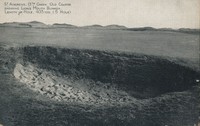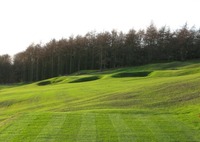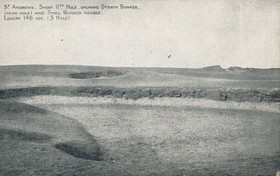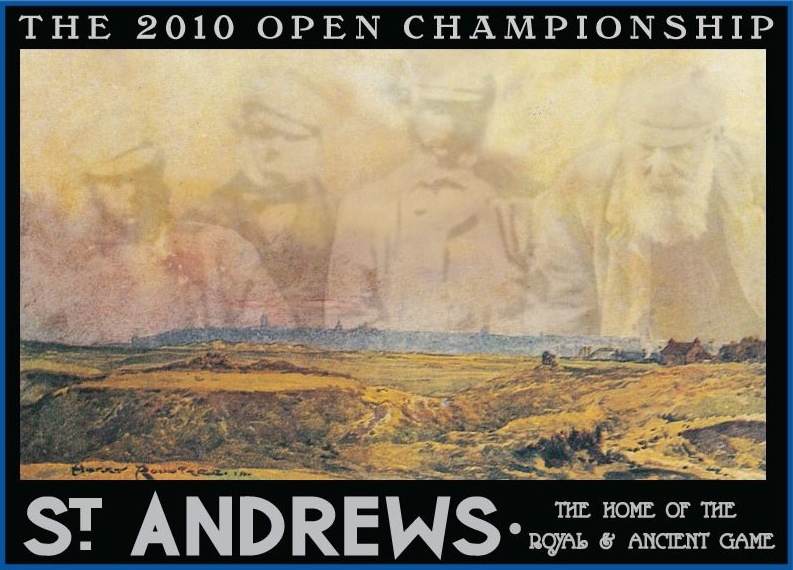No course has been more deserving of thorough analysis and a loving attention to the details of its evolution than the Old Course, and Scott Macpherson done it with St. Andrews: The Evolution Of The Old Course. He compiles rich anecdotes and lavishly illustrates this handsome tome to help us understand just how much the Old Course has evolved and more importantly, why it retains its brilliance.
In Part II of our Q&A on the eve of the 2010 Open Championship, he talks about specifics of the course and his own design work with Greg Turner.
GS: Tell us what you've seen in terms of the Road Hole's "fairway" width evolution. Did the fairway used to open up more toward the first green so that players could bail out but face a much more difficult approach?
 SM: Geoff, as you know, the term 'fairway' is a relatively modern term. But let's not get hung up on that semantic.
SM: Geoff, as you know, the term 'fairway' is a relatively modern term. But let's not get hung up on that semantic.
An article published around 1900's talked of the course in the 1850's and the course was described then as being "very narrow" with the fairways not any wider than "a good broad street". So traditionally there has not been a lot of width on the course. But as you know, with the greater amount of play, the course widened with all the wear from golfers. The grazing sheep (not taken off the course until 1945) also kept the rough grasses down, and kept the 'fairways' wide. But how wide did the 17th hole get? I'm not sure anyone knows, but I think it is safe to say that the corridor has changed over time. Only after the railway Station was built in the 1850's and Old Tom built the 1st green in 1870, and the bunkers down the left of the hole formalized, could it possible be said that the playing corridor was set.
It is probably important to say that with the road running along the back edge of the green, the best line into the green – especially if the flag is at the back, is from an angle that allows a golfer to hit down the length of the green. This is obviously from the far right. How far right could you get? Probably not much right of where you can get today due to the railway station. As regards the area around the green, this hole has only been a par 4 since (and including) the 1960 Open Championship. Few players back in the early 20th century would have got past the Scholar's bunker, so this was the more important area for many decades. Now with the hole being a Par 4 there is greater interest in the Road Hole bunker. (There is possibly too much interest in it actually appearance – it most important aspect is it position and the area from which it gathers balls)
 The 17th in reverse plays as the second hole (From St. Andrews: The Evolution of the Old Course, click image to enlarge)GS: The 17th in the reverse Old Course, which would be the second hole, is depicted in your book and the strategy looks fascinating assuming there's a bit more width. Do you know anyone who has played it?
The 17th in reverse plays as the second hole (From St. Andrews: The Evolution of the Old Course, click image to enlarge)GS: The 17th in the reverse Old Course, which would be the second hole, is depicted in your book and the strategy looks fascinating assuming there's a bit more width. Do you know anyone who has played it?
SM: I have played it many times. A few years ago, the Links Trust started allowing the 'reverse course' to be played in April. I think it was for a week at first. Now they do it every second year for about 2-3 days. The 17th in reverse is a tremendously difficult hole. Particularly the approach shot to the green. The hole becomes a real adventure, and it (and the 12th in reverse) are high-lights of the experience.
GS: You feature a graphic showing just how little square footage is actually pinnable on the Road Hole and Eden greens. Do you know actual square footages of pinnable green space on those holes?
 Scott Macpherson's slope percentage analysis of the Old Course's 11th green (From St. Andrews: The Evolution of the Old Course, click to enlarge)SM: When the greens are running over 10.5 on the stimpmeter, I think the for the 17th green, the pinnable area is just over 300m2. For the 11th, it is about half that – say 150m2. i.e not very much!
Scott Macpherson's slope percentage analysis of the Old Course's 11th green (From St. Andrews: The Evolution of the Old Course, click to enlarge)SM: When the greens are running over 10.5 on the stimpmeter, I think the for the 17th green, the pinnable area is just over 300m2. For the 11th, it is about half that – say 150m2. i.e not very much!
GS: You detail the issues with boundaries on the course, when did the right of the Home hole become out of bounds? Would you prefer it to have no boundary and to see a few shots off of the doorsteps of Tom Morris's golf shop?
SM: The Out-of-Bounds areas became such on the 17th of July 1911. It was mainly a practical solution I understand. I love the 18th hole because the golfers expect to make 3 on it, and yet this hole can provides scores from 2-6 quite easily. No change needed.
 A hazardous bunker, Hole O'Cross, date unknown (Tournament play on the Corner Of The Dyke (Geoff Shackelford Collection, click to enlarge)GS: Which version/era of the Old Course would you most like to play and why?
A hazardous bunker, Hole O'Cross, date unknown (Tournament play on the Corner Of The Dyke (Geoff Shackelford Collection, click to enlarge)GS: Which version/era of the Old Course would you most like to play and why?
There have been some monumental periods in the evolution of the course. If one could time travel, of course it would be fascinating to see and play the course when it was 22 holes and then in about 1850 after the March stones had been put in the course was 18 holes and Halkett's bunker still existed on the 18th fairway. But if I was to choose one period I'd love to go back to 1904-05 and meet Old Tom, Horace Hutchinson, John Low, Garden G Smith, Harry Colt, understand the pressures on the Old Course (extra visitors, new haskell ball, new lawn mowers, Open Championship coming) that culminated in the addition of the 200 yards and extra 13 bunkers. This was a dynamic period – and I wonder how different the pressures where compared to where we were in 2005 with the Pro V1.
GS: They've added tees in some rather bold locations of late, but one thing we learn in your book is that bunkers have come and gone quite regularly until the last fifty or so years. Would you like to see something done besides tees?
SM: I celebrate the men, such as John Low, who have been at the centre of shaping the changes to the course while protecting its spirit. I don't underestimate the difficulty of this at any time, be it in 1900, or 2010, but I wonder if it would be more difficult today, now that millions more know, herald, and worship the Old Course. Having completed the research I see myself as a traditionist not a protectionist, and would like to see the Old Course add some more bunkers – and fill in a few of the obsolete ones – to keep the strategy of the golfing test at it's optimum. e.g. I would like to see the hollow just past the last of the beardies, and in the middle of the 14th fairway, made into a bunker. This would make the longer hitters have to hit the ball down a narrow corridor between the wall and this bunker to get as far down the fairway as possible. The bunker would be in keeping with the Beardies and improve the strategy of the hole.
 GS: Tell us about Close House and your design work there with Greg Turner.
GS: Tell us about Close House and your design work there with Greg Turner.
SM: Not many young architects are getting opportunities to design new courses these days so this project is a huge personal privilege to me. I was approached to design the course in 2004, and it took 5 years before we broke ground in April of 2009. The course is located on an old English mansion property near Newcastle, UK, complete with 200-year old oak trees, Ha-ha's and ancient monuments. I felt that the course needed a theme in keeping with the history of the property and suggested we build the course in the style of Harry Colt. the owner of the property owns many race horses so he liked the equine connection, and the course is to be called the 'Colt'. No two holes on the course follow in the same direction, the course is very strategic with a second shot being rewarded depending on the excellence of the first. The course is designed to look harder than it plays, with some holes having a small degree of mystery that will reward the regular player of the course. For a comparison, the course has almost 300 feet of elevation difference between the highest and lowest points – much like Pasatiempo – (and this is not a bad comparison on another level as Mackenzie use to work with Colt) but the highest point is on the 11th hole, so it is a all down hill to the Clubhouse from there. I am very excited about this course, and look forward to the opening in May/June 2011.













 Sunday, July 11, 2010 at 12:00 PM
Sunday, July 11, 2010 at 12:00 PM












